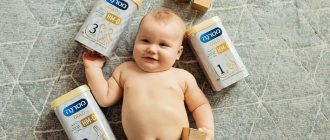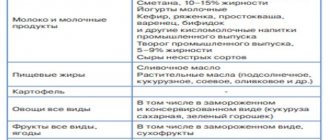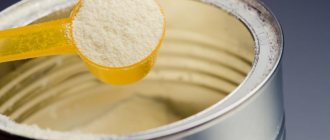Composition of dairy-free mixtures
Infant formulas without cow's milk are labeled "BL", and in English - LF.
In a lactose-free diet, lactose is replaced with another protein. There may be the following options:
- Calcium caseinate. This compound is obtained by protein separation and treatment with calcium hydroxide.
- Whey protein is highly hydrolyzed. It can be obtained if regular milk protein is broken down into its individual components. This procedure reduces the allergenicity of the product for children.
- Casein hydrolysate. To produce it, casein is taken and dissolved in water. In this way, a suspension is obtained, which is subject to proteolytic hydrolysis.
- Soy protein isolate. It is obtained from soybeans. This protein contains all amino acids except methionine. It is added to the composition to increase the value of the product.
- A mixture of amino acids of synthetic origin. This diet is free of even small parts of protein.
In addition to the lactose substitute, the infant formula also contains carbohydrates:
- glucose;
- gluten-free starch, hydrolyzed;
- sucrose;
- maltodextrin.
As in dairy products for baby food, milk fat is replaced with vegetable milk, and vitamins, minerals and other useful components are also present.
Dairy-free soy mixtures
The main protein substitute in soy mixtures is soy isolate . Its composition is close to milk protein and does not contain only methionine. But manufacturers add this component to the mixture separately.
Many parents doubt and do not want to feed their baby soy formula because of the prejudice that soy is a genetically modified product. This is wrong ! Infant formulas use only natural soy and other ingredients. The production and composition of baby food is strictly controlled by the state.
Soy formulas are very popular among parents whose babies are allergic to cow protein. However, they must be used with caution - the child may be allergic to soy . Soy formulas are dairy-free and lactose-free, but they are not hypoallergenic.
Also, soy formula is not recommended for feeding infants under six months of age.
List of soy mixtures
- Nutrilak Soya;
- Nutrilon Soy;
- Frisosoy;
- Humana SL;
- Enfamil Soya;
- Similak Izomil.
In general, the list of soy formulas is quite large; every major baby food manufacturer produces them. The packages are marked “Soy”.
Read more - soy formula for children.
When is it prescribed?
Pediatricians prescribe lactose-free nutrition for children under one year of age due to lactose intolerance (galactosemia) or deficiency. These conditions refer to an inherited inability of the body to produce the enzyme that breaks down lactose, or deficiency. Due to lactose intolerance, various allergic manifestations occur.
After the parents complain, the specialist sends them for diagnostics, and based on the results, determines the child’s health status. If he is completely unable to digest the milk component, he is immediately transferred to lactose-free formulas, and for the rest of his life he will be forced to adhere to a lactose-free diet.
In case of enzyme deficiency, the doctor decides the nutritional tactics, taking into account what type of feeding the baby has.
All formulas containing cow's milk substitutes can be included in a child's diet from birth. To do this, products containing casein hydrolyzate or synthetic amino acids are introduced. The exception is soy mixtures - they are recommended for use after six months of age. Soy-based products may cause allergies to its protein.
When do you need lactose-free formulas?
Human milk or artificial milk formulas, if unavailable, are an important component of the diet of children in the first year of life; they contain the necessary proteins, fats, carbohydrates, vitamins and minerals to ensure adequate growth and development of the child.
Lactose is the main carbohydrate in breast milk and infant formulas that are made from milk. In order to digest lactose, the intestines need an enzyme - lactase, which is produced in the gastrointestinal tract.
If there is not enough lactase enzyme in the baby’s body, this leads to lactase deficiency. Let's look at why this happens?
- Congenital lactase deficiency
- primary lactase deficiency, characterized by a congenital deficiency of the lactase enzyme, is usually hereditary. It is extremely rare. - Secondary lactase deficiency
is diagnosed more often - often in children in the first year of life, due to insufficient functioning of the lactase enzyme when the gastrointestinal tract is immature, for example in premature infants. Temporary secondary lactase deficiency can occur with intestinal infections with diarrhea. In most cases, secondary lactase deficiency resolves after correction of the child’s diet and as the gastrointestinal tract develops. - Galactosemia
is a rare, hereditary disease in which the functioning of the enzymes responsible for further digestion of the carbohydrate lactose is disrupted.
Properly organized diet therapy is one of the main methods of treating lactase deficiency, both secondary and congenital.
In case of primary lactase deficiency, diet therapy is prescribed for life, and in case of secondary deficiency, it is prescribed as a component of treatment (single or with the addition of lactase enzyme medications).
As a rule, a formula-fed baby is prescribed lactose-free formulas, and any types of milk and dairy products, as well as foods and dishes containing them, are excluded from the child’s diet.
Highly adapted lactose-free infant formulas can be used from birth and throughout the first year of life. Instead of milk sugar - lactose, the carbohydrate component of such mixtures is represented by a glucose derivative - dextrine maltose. Lactose-free infant formula must contain all the necessary nutrients for the proper growth and development of the child.
Types of dairy-free infant formulas
Dairy-free products are divided into 3 large types:
- Dairy-free lactose-free. The peculiarity of these mixtures is that they are not tasty without milk, because lactose gives that slight sweetness that is present in ordinary infant breast milk substitutes. Therefore, manufacturers add the above carbohydrates.
- Soy-free dairy. Mixtures based on soybean isolate are close in composition to conventional adapted mixtures, only methionine is missing. It is added additionally. Parents do not need to worry that genetically modified soybeans are used, since there is government control over the release of baby food products.
- With goat's milk. Today it is believed that goat's milk is much closer in composition to women's milk than cow's milk. This mixture has easier-to-digest protein, so it is easier for the baby’s body to digest it. But there are children who, with an allergic reaction to cow's milk protein, also have a negative body reaction to goat's milk. Although this milk is fattier, it is easier to digest in the digestive system of babies.
The main thing that parents should remember is that they will not decide on the choice of formula for their baby, but this should be done by a specialist after receiving the examination results and the characteristics of allergic reactions on an individual basis.
When are dairy-free formulas prescribed?
Indications for the prescription of lactose-free mixtures are diseases associated with complete or partial intolerance to lactose or galactose (a component of lactose). Complete lactose intolerance refers to the genetic inability of the body to produce the enzyme that breaks down lactose, and secondary lactose intolerance refers to its insufficient production. In the first case, the child is immediately transferred to lactose-free formula and maintains a lactose-free diet throughout his life. In the second case, the tactics of use are determined by the doctor and depend on the type of feeding of the child.
When breastfeeding, first of all, they try to preserve mother's milk, so lactase drugs are first prescribed, and only if treatment is ineffective, part of the breast milk is gradually replaced with formula. When artificial feeding, lactose-free formulas are not prescribed. Instead, low-lactose baby food is used, since complete exclusion of lactose is undesirable for a child. After 5-7 days from the start of treatment, symptoms of lactase deficiency usually disappear. For galactosemia, which is a congenital disease associated with galactose intolerance, only artificial nutrition is used with the complete absence of lactose and galactose (with casein hydrolyzate, casein-dominant, amino acid-based, soybean isolate), which makes mixtures containing 50-60% whey unacceptable. proteins. It is best to use food based on soy protein isolate, and in case of an allergy to it, switch completely or partially to products with casein hydrolyzate or from a set of synthetic amino acids. The transition to a new diet is carried out gradually, starting with small portions.
Nutrition for children with casein hydrolyzate, highly hydrolyzed whey protein and amino acids is used for moderate and severe forms of allergy to cow's milk protein. Read more about hypoallergenic mixtures in the article.
The absence of cow's milk protein and lactose in soy mixtures makes it possible to use them when a child reaches the age of 5-6 months as a therapeutic food for food allergies to cow's milk protein, galactosemia and lactase deficiency.
Before using soy-based food, you must be sure that the child’s immediate relatives are not allergic to legume protein, since there is a high probability that a similar reaction will be observed in the child. Even if the closest relatives do not have anything like this, it is still necessary to monitor the child for skin rashes, diarrhea, and regurgitation.
Soy mixtures begin to be given in small portions, gradually increasing the amount of food to the required amount over 5-7 days. You should not immediately expect a therapeutic effect; tangible results will appear only after 3-4 weeks from the start of their use. On average, the course of treatment is 3-6 months.
List of best products
Every parent strives to give their child the best quality, especially when it comes to nutrition. But what mixtures are the best for babies?
Each of the existing products has both disadvantages and advantages:
- Bellakt is lactose-free. The product is intended for babies with lactose intolerance, colic, and diarrhea. It has a proportion of whey proteins to casein - 60/40, and contains maltodextrin.
- "Celia" is lactose-free. The food is recommended for infants with galactosemia, acute gastroenteritis, and diarrhea. The proportion of whey proteins to casein is 60/40, there is maltodextrin.
- "Nutrilon Premium". Protein in the form of casein, glucose syrup added. For infants with lactose intolerance.
- “Babushkino Lukoshko” lactose-free. The mixture is intended for children with galactosemia. Protein is casein, there is glucose syrup and maltodextrin.
- "Nan" is lactose-free. The product is made for babies 1 year of age with lactose intolerance and impaired absorption of certain nutritional components from the small intestine. The proportion of whey proteins to casein is 60/40, including maltodextrin.
The presented food without cow's milk is quite varied, so when choosing, they focus on the composition, country of origin and cost of the product.
The subtleties of feeding a child dairy-free food
All parents of children with galactosemia or lactose deficiency should know how to properly use dairy-free formula. You should not give this product on your own without a doctor’s recommendation, even if it is used for preventive purposes. If the baby has a high degree of predisposition to allergic reactions, then the pediatrician should know about this. He will decide at his own discretion whether to provide therapeutic or preventive nutrition.
You need to gradually switch from a regular adapted formula to a dairy-free product.
Hypoallergenic food is first added 30 ml to the second feeding. Each time its dosage increases little by little. First, the second and last feeding is completely replaced, and eventually all the others.
You cannot combine hypoallergenic with adapted mixtures. The process of feeding newborns is as follows: first, familiar food, and then therapeutic nutrition. After 14 days you will notice the first changes.
You need to be attentive to your child and monitor whether there is an allergic reaction to a dairy-free product. This sounds strange, but such a reaction of a child’s body is not uncommon.
Pros and cons of specialized nutrition for allergy sufferers
The advantage of a dairy-free product is its therapeutic and prophylactic effect in case of lactose deficiency or galactosemia.
It is more easily tolerated by small bodies with a deficiency or absence of the enzyme that helps digest lactose.
The disadvantages include the fact that the cost of such food is noticeably higher than traditional mixtures. Even these hypoallergenic products can cause allergic reactions in babies. This is especially true for soy based nutrition.
Preventive hypoallergenic mixtures
Today, the market offers a wide selection of hypoallergenic mixtures for the prevention of unwanted conditions. They are prescribed by pediatricians in case of signs of allergies or a tendency to it.
These baby food products are made from cow's milk protein that is subject to partial hydrolysis.
After this process, the digestibility of the mixture increases, and as a result, the likelihood of the absence of an allergic reaction on the part of the child’s body increases. But if signs of atopy to cow's milk protein appear earlier, such products will not be suitable. Therefore, preventative nutrition is not used for moderate or severe allergies. Preventive mixtures are marked GA, which means that this food is low-allergenic.
If parents notice that the child’s nutrition needs correction, they should seek advice from a local pediatrician, but under no circumstances experiment on their own. After your visit, the doctor will make a diagnosis and tell you which products will be optimal for the baby.
Basic composition
Dairy-free formulas are a type of baby food. This product is used to prevent the onset or reduce symptoms of food allergies.
They are based on protein hydrolysates or soy proteins. In them, large milk molecules are broken down into smaller ones, so their ability to provoke an allergic reaction is reduced, and absorption by the child’s body increases.
The basic composition of dairy-free formulas is represented by the following components:
- vegetable oils;
- hydrolyzed cow's milk soy protein isolate;
- minerals;
- vitamins;
- amino acids.
Pediatricians recommend giving dairy-free products to children who suffer from galactose and lactose intolerance or are predisposed to this condition.









